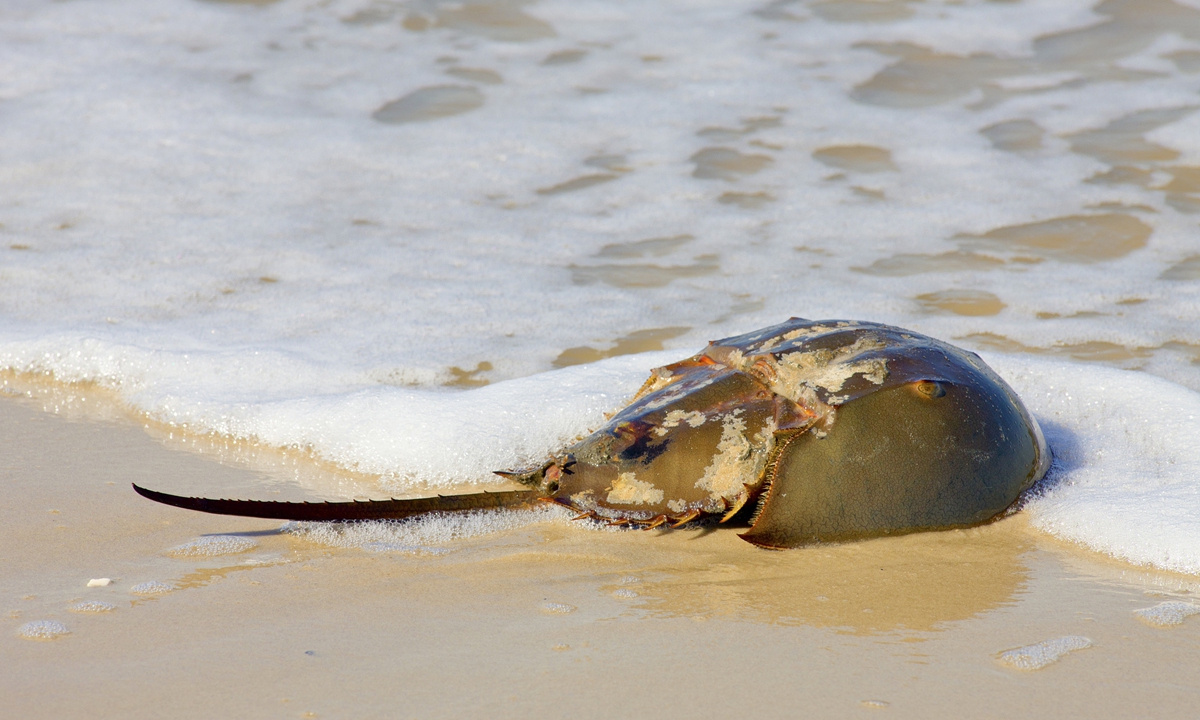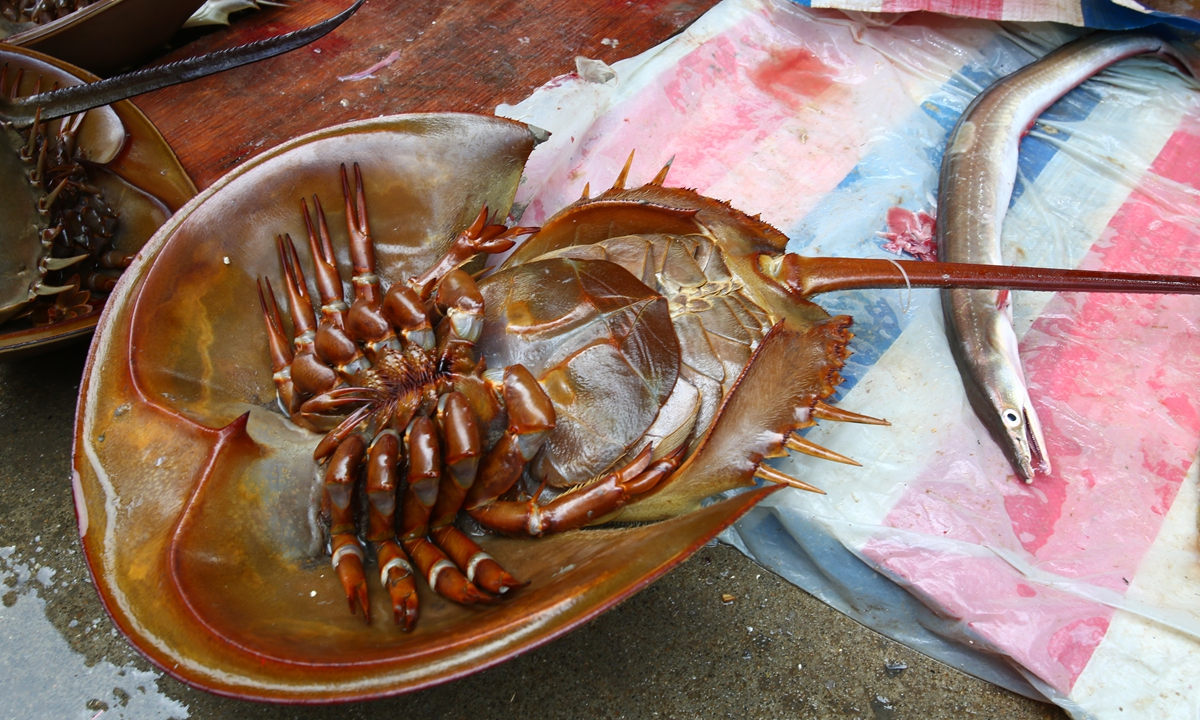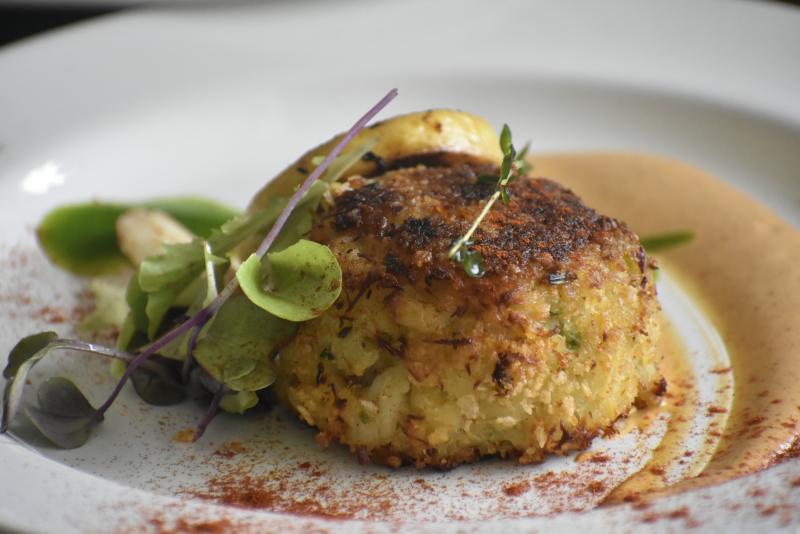Declining number of horseshoe crabs - the alien-looking marine creature with blue blood containing ancient immunity properties that are an essential to develop a COVID-19 vaccine - has scientist, pharmaceutical companies, NGOs and local governments worried.
Scientists are now working on the sustainability of horseshoe crabs, even as China has mastered captive breeding of the animal that takes some 10 years to reach maturity.
Moreover, in recent years, people in China have been working to lifting protection of it.

A horseshoe crab Photo: IC
A key to COVID-19 vaccine
The horseshoe crab is a living fossil that has been on Earth for 450 million years, before many dinosaurs existed. Its blue blood is extremely sensitive to germs and is used for numerous purposes.
Since the onset of the coronavirus pandemic, the animal has been much sought after by scientists and pharmaceutical companies developing COVID-19 vaccines.
According to a National Geographic article in July, the Swiss-based Lonza, which was about to manufacturing a COVID-19 vaccine for human clinical trials, have to test its product with the blood of the crab to gain access to the US market.
The Chinese horseshoe crab's blood extract - tachypleus amebocyte lysate (TAL) - is widely used in pharmaceutical industry for endotoxin detection, according to an article published by the Journal of Biology in 2017. The TAL is currently the most effective and simple lysate to detect endotoxin, it reported.
An employee in a factory that produces horseshoe crab lysate products confirmed with the Global Times that their products have been supplying companies developing COVID-19 vaccines in China.
"If even tiny amounts of endotoxin - a type of bacterial toxin - make their way into vaccines, injectable drugs, or other sterile pharmaceuticals such as artificial knees and hips, the results can be deadly, reads the article by the National geographic in July.
The horseshoe crabs' lysate is embodied in the Chinese and US pharmacopeias as the detection method of endotoxin. The extract of blood cells from the Atlantic horseshoe crab in the US is known as the limulus amebocyte lysate (LAL).
"The horseshoe crab lysate is currently indispensable," Hu Menghong, a professor at the Shanghai Ocean University and a horseshoe crab expert, told the Global Times on Thursday. An artificial replacement is "unstable, so traditional TAL and LAL are still widely used in medicines," said Hu.
Insufficient supply
Not many countries in the world have access to the horseshoe crab. China is one of the few with horseshoe crab habitats, which are along the seashores in eastern and southern China, according to an article of Journal of Biology.
China is the main supplier of the TAL/LAL in the world, along with the US and Japan.
But even in China, there's concern about a sufficient supply of TAL.
"Several years ago, the TAL supply was sufficient for the domestic industry. But in recent years, it is hard to estimate, as China is exporting and importing it," Hu said.
In March, the customs department in Zhanjiang, South China's Guangdong Province allowed a local pharmaceutical factory to import TAL from the US to pass the customs rapidly to ensure the production of medicines, according to a report on the website of the Zhanjiang Customs.
"Currently, there is insufficient horseshoe crab lysate during the COVID-19 epidemic," read the report.
To collect the blood of horseshoe crabs, pharmaceutical factories capture them, extract their blood and then release them back to nature. It is estimated that as many as 30 percent die after being bled, the National Geographic reported quoting a 2010 study on the industry in the US.
In China, the death rate of bled crabs has not been studied, according to Hu, who applied for a research in 2019, which has not yet been approved. "We do not know how many horseshoe crabs, after losing 30 percent of their blood, survive after they are returned to the ocean. We wanted to trace them by tagging the bled crabs."
In China, five or six pharmaceutical factories would be given permissions to draw blood from certain number of horseshoe crabs each year to produce TAL.
In October 2019, 1,176 adult Chinese horseshoe crabs were re-released into the ocean by the local fishery department and a pharmaceutical factory after they were bled in Beihai, Guangdong, the Beihai Daily reported.
"It is unknown whether the factories capture more crabs than is permitted as nobody would know if they did," Lin Wuying, a researcher on natural conservation who is working on horseshoe crab research and protection.

Horseshoe crabs are sold in a seafood market in Xiamen, East China's Fujian Province photo: IC
Sustainable living
The population of horseshoe crabs is dropping in both China and the US.
"Things around the species are contradictory. The resource is declining, its value for utilization keeps rising," Hu said, noting that captive breeding is the key solution.
"In the wild, the survival rate of the eggs is only 0.1 percent," Hu said. As early as in 2006, a research team in Guangxi Oceanic Institute successfully incubated more than 200,000 Chinese horseshoe crab eggs. The incubation rate reached 90 percent, the Xinhua News Agency reported.
The only problem is that the sexual maturity of horseshoe crabs is 10 years. "So the earlier we act and the more we breed, the greater the future supply we'll have," Hu said.
The blood of horseshoe crabs' mysteries immunity mechanism has many other functions. "It has more than 50 bioactive substances that are related to human health," Hu said.
In the habitats of Chiense horseshoe crabs, people have been working to conserve the species in recent years. Some people, including Lin, want the horseshoe crab to be on the list of 2nd Class Protection Animal.
Guangdong has been releasing farmed crabs into the wild. The project is also being promoted in Fujian and Zhejiang provinces in East China, the Zhanjiang Evening News reported in 2019.
RELATED ARTICLES:
August 28, 2020 at 02:18AM
https://ift.tt/31CgghJ
China seeks to manage supply of horseshoe crab's indispensable blood in race to develop COVID-19 vaccines - Global Times
https://ift.tt/2MkGRbk
Crab

No comments:
Post a Comment